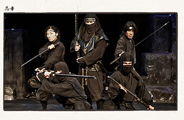Mount Fuji, a symbol of Japan.
It's Japan’s tallest mountain, but that's not the only amazing thing about it.
Understand just how much it's loved by the people of Japan,and surely visiting Mount Fuji will be that much more charming.
To Japanese people, Mount Fuji is so special
 36 Views of Mount Fuji is a series of works by Katsushika Hokusai that depicts landscapes with Mount Fuji. This image is Fujimigahara in Owari Province.
36 Views of Mount Fuji is a series of works by Katsushika Hokusai that depicts landscapes with Mount Fuji. This image is Fujimigahara in Owari Province.
that people are grateful even to catch a mere glimpse of it!!
Mount Fuji towers into the sky, sitting between Yamanashi and Shizuoka prefectures. It appears largest from these two prefectures, but in the ukiyoe (wood block print) Thirty-six Views of Mount Fuji (Fugaku sanju rokkei), the mountain is also drawn from the viewpoint of locations that currently correspond to the prefectures of Kanagawa, Tokyo, Chiba, Ibaraki, Nagano, and Aichi. In the work that depicts the view of Mount Fuji from Aichi, Fujimigahara in Owari Province (Bishu Fujimigahara), Mount Fuji can only be seen far off in the distance and appears very small. Through the ages, people in Japan have felt a sense of longing when seeing scenery with Mount Fuji in the distance.
 Mounds (tsuka) were built by piling lava from Mount Fuji and hardening it. Many of these "Fujizuka" remain to this day.
Mounds (tsuka) were built by piling lava from Mount Fuji and hardening it. Many of these "Fujizuka" remain to this day.
People must stand at the summit at least once in their lives!
From long ago, Japanese people have thought of Mount Fuji as a holy mountain and have been amazed by its magnificence. Visits to Mount Fuji gained the most popularity in the Edo Period (1603-1868). For common people at the time, the financial burden of making the journey was too large and the visit was but a dream. But many could not bear to give up that dream. They carried lava from Mount Fuji and created small mounds (tsuka) that represent the mountain in areas around the Kanto region. These are "Fujizuka," mounds commonly referred to as "O-Fuji San" (a respectful term that refers to Mount Fuji). It's said that by climbing these mounds, common people felt they could be blessed by the sacred Mount Fuji. That sense of yearning—that feeling that one must climb it someday—is as powerful today as it was in the past.
 Mount Nantaisan, in Tochigi's famous tourist city Nikko, also has such a nickname: "Nikko Fuji."
Mount Nantaisan, in Tochigi's famous tourist city Nikko, also has such a nickname: "Nikko Fuji."
A desire to always remain by its side...
As far north as Hokkaido and as far south as Okinawa, there are areas around Japan with mountains that have nicknames referring to Mount Fuji. For example, Mount Yoteizan in Hokkaido is "Ezo Fuji" and Mount Iwakisan in the Tohoku region is "Tsugaru Fuji." Such names, which refer to "the local Fuji" or "the hometown Fuji," number over 300 according to one estimate! To Japanese people, Mount Fuji has a name that symbolizes a beautiful mountain. It has a presence that people want to always keep close.
Mount Fuji Statistics
3,776m(12,389 ft), the highest in Japan!

Location
The border of Yamanashi and Shizuoka. Fujisan Station, on the Fuji Kyuko Line, has easy access to "Fuji Subaru Line Gogome," a major mountain trail. It can be reached in about 2 hours from Tokyo's JR Shinjuku Station, and in about 4 hours from Nagoya Station. From Nagoya Station, one can access JR Gotemba Station, which is near Mount Fuji, in some 2.5 hours! * This assumes that all transportation is by train, and is an estimate of the minimum time.
Climb,View,Feel its Spiritual Power,Play
Climbers in the summer of 2012 (who reached the Hachigome level or higher) numbered over 310,000! (Ministry of the Environment, Kanto Regional Environment Office survey)
Its beauty is also unrivalled in Japan! As this mountain has appeared as a motif in so many works of art, it’s certainly worth taking in with your own eyes.
In addition to the summit, there are also many shrines around the base. It just may be the premier power spot in Japan!
There is an amusement park, and there are also many entertainment locations in areas such as Gotemba, Fuji Yoshida, and Lake Kawaguchi at the base.
Mount Fuji has become a World Cultural Heritage Site!

In 1992, a petition was started to make Mount Fuji a World Heritage Site. Just about 20 years later, in June of 2013, Mount Fuji's was officially registered as a World Cultural Heritage Site. The deciding factors were its religious significance and its inspiring role in so many works of art. In addition to its sublime, beautiful appearance, the mountain has been worshiped since long ago as a mountain inhabited by gods. Mount Fuji was particularly noted for its cultural impact. It has been featured in many haiku and tanka poems and been the motif in paintings and ukiyoe, as well as the subject of many literary works. Perhaps in the future, Mount Fuji, the famous mountain that has captivated Japanese people over so many years, will aim to be a mountain that is known on a global scale.
Choosing a country will allow you to access local content and enable you to shop in your local currency.


























